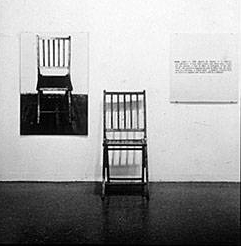
Resisting the arch formalism that had become institutionalized by the 1960s, Conceptual Art has sought to analyze the ideas underlying the creation and reception of art, rather than to elaborate another stylistic convention in the historical succession of Modernist avant-garde movements.
Investigations by Conceptual artists into the networks of signification and structures of knowledge that enable art to have meaning, frequently have utilized text as a strategic device to examine the interstice between visual and verbal languages as semiotic systems. In this regard, Conceptual Art is a meta-critical and self-reflexive art practice, engaged in theorizing the possibilities of signification (including its own) in art's multiple contexts, including its history, criticism, and historiography, its exhibition spaces and markets, and so on.
In interrogating the relationship between ideas and art, Conceptual Art de-emphasized the value traditionally accorded to the materiality of art objects and placed greater emphasis on revealing the semantic systems that make it possible for meaning to be communicated.
One
and Three Chairs, Joseph Kosuth, 1965